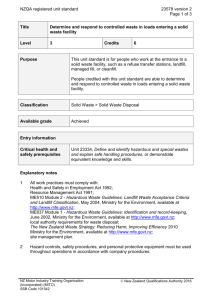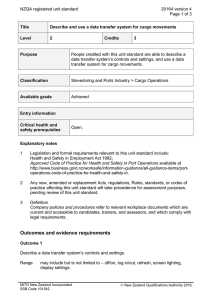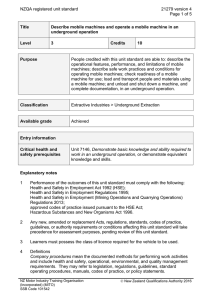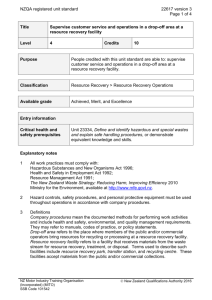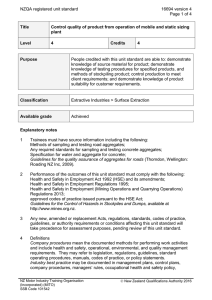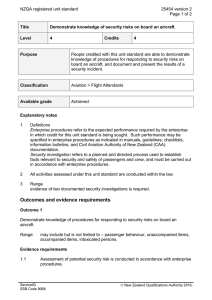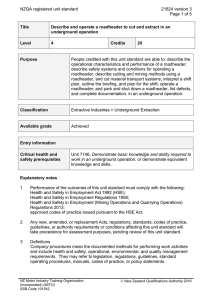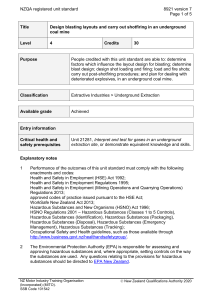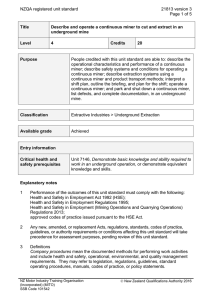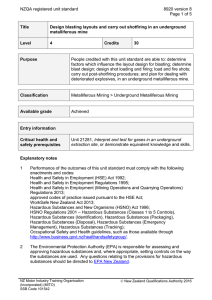NZQA registered unit standard 21663 version 3 Page 1 of 6
advertisement
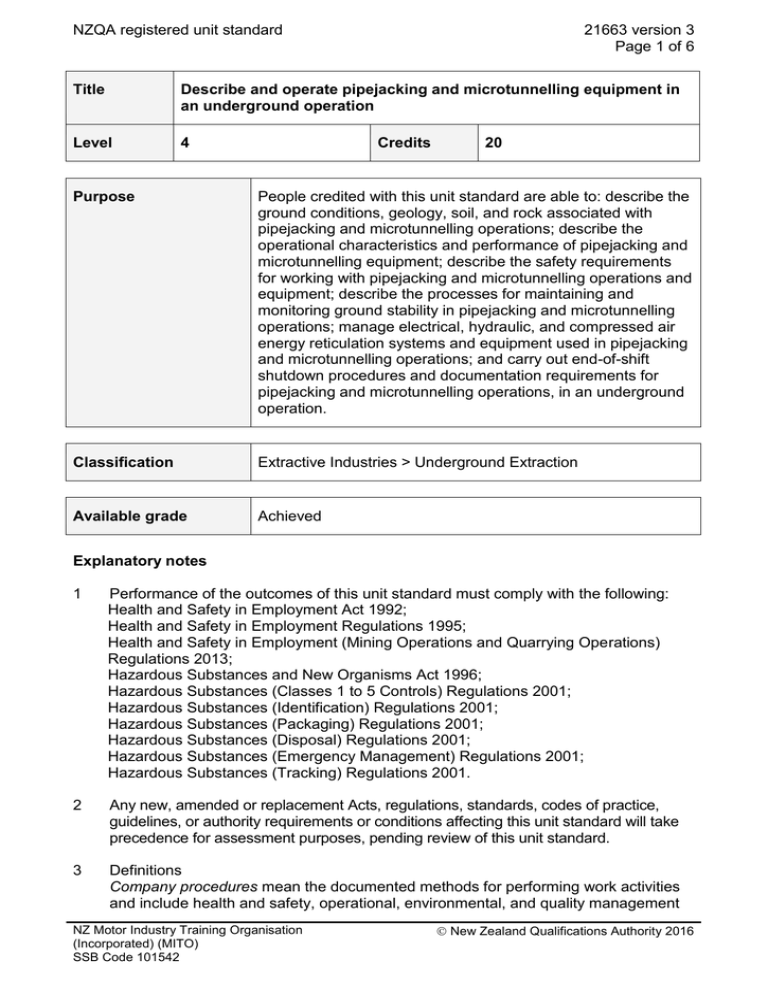
NZQA registered unit standard 21663 version 3 Page 1 of 6 Title Describe and operate pipejacking and microtunnelling equipment in an underground operation Level 4 Credits 20 Purpose People credited with this unit standard are able to: describe the ground conditions, geology, soil, and rock associated with pipejacking and microtunnelling operations; describe the operational characteristics and performance of pipejacking and microtunnelling equipment; describe the safety requirements for working with pipejacking and microtunnelling operations and equipment; describe the processes for maintaining and monitoring ground stability in pipejacking and microtunnelling operations; manage electrical, hydraulic, and compressed air energy reticulation systems and equipment used in pipejacking and microtunnelling operations; and carry out end-of-shift shutdown procedures and documentation requirements for pipejacking and microtunnelling operations, in an underground operation. Classification Extractive Industries > Underground Extraction Available grade Achieved Explanatory notes 1 Performance of the outcomes of this unit standard must comply with the following: Health and Safety in Employment Act 1992; Health and Safety in Employment Regulations 1995; Health and Safety in Employment (Mining Operations and Quarrying Operations) Regulations 2013; Hazardous Substances and New Organisms Act 1996; Hazardous Substances (Classes 1 to 5 Controls) Regulations 2001; Hazardous Substances (Identification) Regulations 2001; Hazardous Substances (Packaging) Regulations 2001; Hazardous Substances (Disposal) Regulations 2001; Hazardous Substances (Emergency Management) Regulations 2001; Hazardous Substances (Tracking) Regulations 2001. 2 Any new, amended or replacement Acts, regulations, standards, codes of practice, guidelines, or authority requirements or conditions affecting this unit standard will take precedence for assessment purposes, pending review of this unit standard. 3 Definitions Company procedures mean the documented methods for performing work activities and include health and safety, operational, environmental, and quality management NZ Motor Industry Training Organisation (Incorporated) (MITO) SSB Code 101542 New Zealand Qualifications Authority 2016 NZQA registered unit standard 21663 version 3 Page 2 of 6 requirements. They may refer to legislation, regulations, guidelines, standard operating procedures, manuals, codes of practice, or policy statements. Industry best practice may be documented in management plans, control plans, company procedures, managers’ rules, occupational health and safety policy, industry guidelines, codes of practice, manufacturers’ instructions, and safe working and/or job procedures (or equivalent). PPE refers to personal protective equipment. 4 An underground operation includes extractive or tunnelling operations. 5 The Pipe Jacking Association (UK) guideline relevant to this unit standard is Tunnelling and Pipejacking: Guidance for Designers - Internal dimensions for pipejacks and tunnels below 3m diameter and indicative drive lengths, Health & Safety Executive, British Tunnelling Society, Pipe Jacking Association, available at http://www.hse.gov.uk/construction/. Outcomes and evidence requirements Outcome 1 Describe the ground conditions, geology, soil, and rock associated with pipejacking and microtunnelling operations. Evidence requirements 1.1 The ground conditions and geology for underground operations are described in terms of the use of the pipejacking and microtunnelling equipment and methods. Range 1.2 includes but is not limited to – unconsolidated ground, old tip areas, geological structures and features, weak zones, access shaft sinking. Soil and rock types at underground operations are described in terms of their general strength and behaviour. Outcome 2 Describe the operational characteristics and performance of pipejacking and microtunnelling equipment. Evidence requirements 2.1 The performance and specifications of pipejacking and microtunnelling equipment are described in terms of its operation at an underground site. 2.2 Equipment is identified and matched in accordance with planning requirements and job conditions. Range may include but is not limited to – pipejacking and microtunnelling equipment, tunnel boring machines (TBM), guidance systems, NZ Motor Industry Training Organisation (Incorporated) (MITO) SSB Code 101542 New Zealand Qualifications Authority 2016 NZQA registered unit standard 21663 version 3 Page 3 of 6 laser sights, pipes, hoses, connections, anchors, lubrication, interjacks, shafts, separation plants. 2.3 The set-up and equipment operational procedures are described in accordance with manufacturer’s specifications and company procedures. Range 2.4 includes but is not limited to – surface plant, set-up, pre-start checks, ventilation, survey sights, energy supply, access, equipment availability, operation. Excavation and spoil removal and processing are described in accordance with industry best practice and company procedures. Range may include but is not limited to – surface located equipment, pipejacking, microtunnelling, surface processing and waste disposal, slurry systems, pumps, sludge ponds, waste dumps. Outcome 3 Describe the safety requirements for working with pipejacking and microtunnelling operations and equipment. Evidence requirements 3.1 Safety requirements are described in accordance with legislation, industry best, practice and company procedures. Range 3.2 Isolation procedures are described in terms of the requirements for pipejacking and microtunnelling operations. Range 3.3 includes but is not limited to – lockouts and tag systems, placing and lifting isolations, reporting. Access procedures to manage confined space working areas and inundation are described in terms of the requirements for pipejacking and microtunnelling operations. Range 3.4 includes but is not limited to – hazard identification and control, safety features of the equipment, signs, barriers, alarms, communication, gas monitoring, ventilation, fire protection, hazardous substances, PPE, emergency provisions, emergency procedures. includes but is not limited to – Pipe Jacking Association (UK) guideline, working around and over energised equipment, face isolation, head interventions, compressed air work. Crane safety in shaft operations is described in terms of the requirements for pipejacking and microtunnelling operations. NZ Motor Industry Training Organisation (Incorporated) (MITO) SSB Code 101542 New Zealand Qualifications Authority 2016 NZQA registered unit standard Range 21663 version 3 Page 4 of 6 includes but is not limited to – lift plans, crane and rigging safety inspections, rigging and dogman understanding, working around suspended loads. Outcome 4 Describe the processes for maintaining and monitoring ground stability in pipejacking and microtunnelling operations. Evidence requirements 4.1 The processes for monitoring and maintaining ground stability are described in accordance with industry best practice and company procedures. Range includes but is not limited to – shaft sinking and maintenance, water content and inflow, slumping, side and roof failure, fissures and weak zones, surface deformation. Outcome 5 Manage electrical, hydraulic, and compressed air energy reticulation systems and equipment used in pipejacking and microtunnelling operations. Evidence requirements 5.1 The components, equipment, and operation of electrical reticulation are managed in accordance with the manufacturer’s specifications, plant operation plan, industry best practice, and company procedures. Range 5.2 The components, equipment, and operation of compressed air systems are managed in accordance with the manufacturer’s specifications, plant operation plan, industry best practice, and company procedures. Range 5.3 includes but is not limited to – air power, compressors, motors, valves, sensors, water traps, receivers, pipes, connectors, filtration, leakage, seals. The components, equipment, and operation of hydraulic systems are managed in accordance with the manufacturer’s specifications, plant operation plan, industry best practice, and company procedures. Range 5.4 includes but is not limited to – cables, joint boxes, connectors, lighting, signalling systems, switchgear, circuit breakers, transformers, circuits, fault display, instruments. includes but is not limited to – oil power, pumps, motors, valves, sensors, pipes, connectors, filtration, leakage, seals, flammability, environmental considerations. The guidance of TBMs using lasers, GPS and other systems are managed in accordance with manufacturer’s specifications, plant operation plan, industry best practice and company procedures. NZ Motor Industry Training Organisation (Incorporated) (MITO) SSB Code 101542 New Zealand Qualifications Authority 2016 NZQA registered unit standard 21663 version 3 Page 5 of 6 Outcome 6 Carry out end-of-shift shutdown procedures and documentation requirements for pipejacking and microtunnelling operations. Evidence requirements 6.1 The plant and equipment is shut down in accordance with the manufacturer’s specifications, plant operation plan, industry best practice, and company procedures. 6.2 Face stability management and monitoring procedures are carried out in accordance with plant operation plan, industry best practice, and company procedures. 6.3 Defects are reported in accordance with industry best practice and company procedures. includes but is not limited to – plant and associated equipment inspections, hazard inspections, reports, maintenance. Range 6.4 Documentation is completed in accordance with company procedures. includes but is not limited to – plant operator log sheets, hazard reports, defect reports. Range Planned review date 31 December 2019 Status information and last date for assessment for superseded versions Process Version Date Last Date for Assessment Registration 1 27 June 2005 31 December 2017 Review 2 21 August 2009 31 December 2017 Review 3 18 June 2015 N/A Consent and Moderation Requirements (CMR) reference 0114 This CMR can be accessed at http://www.nzqa.govt.nz/framework/search/index.do. Please note Providers must be granted consent to assess against standards (accredited) by NZQA, before they can report credits from assessment against unit standards or deliver courses of study leading to that assessment. Industry Training Organisations must be granted consent to assess against standards by NZQA before they can register credits from assessment against unit standards. NZ Motor Industry Training Organisation (Incorporated) (MITO) SSB Code 101542 New Zealand Qualifications Authority 2016 NZQA registered unit standard 21663 version 3 Page 6 of 6 Providers and Industry Training Organisations, which have been granted consent and which are assessing against unit standards must engage with the moderation system that applies to those standards. Requirements for consent to assess and an outline of the moderation system that applies to this standard are outlined in the Consent and Moderation Requirements (CMR). The CMR also includes useful information about special requirements for organisations wishing to develop education and training programmes, such as minimum qualifications for tutors and assessors, and special resource requirements. Comments on this unit standard Please contact the NZ Motor Industry Training Organisation (Incorporated) (MITO) info@mito.org.nz if you wish to suggest changes to the content of this unit standard. NZ Motor Industry Training Organisation (Incorporated) (MITO) SSB Code 101542 New Zealand Qualifications Authority 2016
